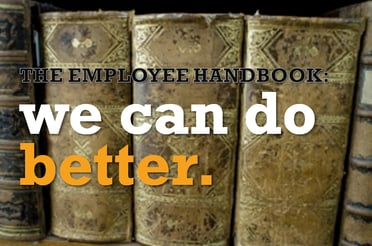JANINE TRACY
Director of People at HNI
Employee handbooks are largely viewed as a necessary evil. They are a compilation of policies, forms, benefits details, and of course, language to CYA in the event of an employment dispute. 
We painstakingly drag our new hires through these, make them sign off acknowledging they’ve read every word, and then it sits on a shelf gathering dust.
This is a missed opportunity.
Rather than handing new employees a stack of legalese on their first day, what if we gave them something that actually engaged and inspired them?
That shared information about the company and expectations – but in a way that made them excited to be a part of your organization?
We're all guilty of this...
We’re in growth mode and are hiring a lot of new team members – which made us think twice about the kind of message we were sending with our own employee handbook.
So we dusted it off and actually dug into the 50-page document that no one reads.
Here’s one of the first paragraphs where we really set the tone:
“For the purpose of this handbook, HNI Risk Services, LLC will hereinafter be referred to collectively as “HNI”. This handbook is not intended to create a contract of employment between the company and any of its employees or otherwise alter or modify employees’ at-will status. These policies and procedures offer a set of guidelines for the implementation of these policies and procedures. They are subject to change from time to time and do not confer any obligation on HNI or right to employment. Notwithstanding any of the provisions of these policies and procedures, employment may be terminated at any time for any reason with or without notice either by the employee or by HNI. The company’s policy for discipline in no way limits or alters the at-will employment relationship.”
Not exactly riveting stuff. And do we really want the very first introduction to our HR policies to be “we can still fire you and this handbook doesn’t mean we can’t?”
We’ve got a whole team of risk managers, so we get it – it’s important to ensure you have documentation of your policies and how they’ve been administered. But it doesn’t have to be a total snorefest or exist only for when you get sued.
Bringing the employee handbook into the 21st century
With that “aha!” moment, we challenged ourselves to reshape the message that we were sending in these documents.
We wanted to use our employee facing documents to showcase the values, perks, and cultural norms that make this a great place to work. We wanted to preserve the excitement that new employees have on their first day and build on it by showing that CHANGE THE GAME isn’t just a marketing message – it’s what we live every single day.
Here’s a sneak peek at a few of the pages of the finished product:
The opportunity to “sell” your organization to talent
Companies invest thousands crafting marketing and advertising messages. But what about marketing to your people?
Your employer brand is built through every touchpoint and communication with your current and prospective employees. Everything — from the application, to benefits communication, to the exit interview — is a chance to influence your brand image.
You could have the best culture, the best pay, and the best benefits package in the world, but if people don’t understand or see the value, you’re not capturing the full potential of those investments.
Talented individuals have choices about the organizations they choose to give their blood, sweat, and tears to. The companies that win will be those who can create value – and then drive that message home.
Related Posts
Careers at HNI: Join our team!
Dear Gamechangers-In-Training: Thanks for Attending Bring Your Child to Work Day
Technology & The Rise of the Fauxmergency
My Escalator is Broken.5 Tips to Keep Benefits Communication Flowing Year Round
.png?width=69&height=53&name=Acrisure%20Logo%20(White%20Horizontal).png)

